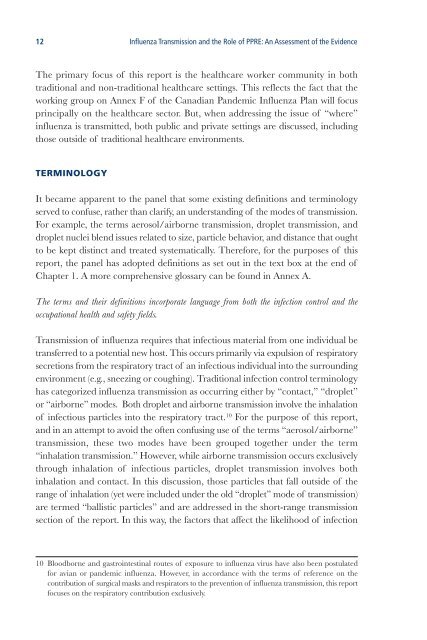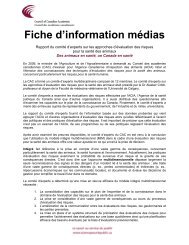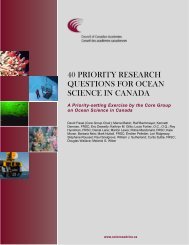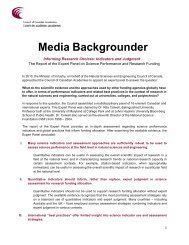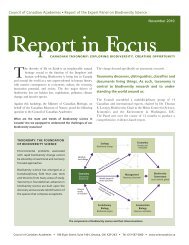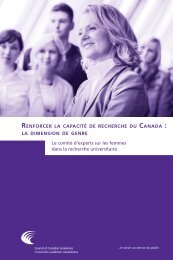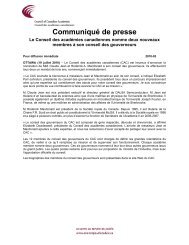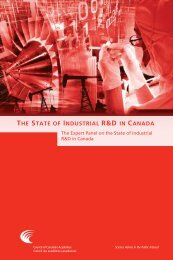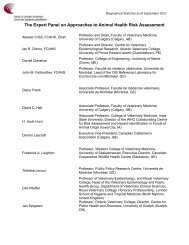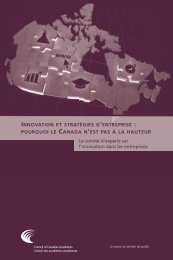an assessment of the evidence - Council of Canadian Academies
an assessment of the evidence - Council of Canadian Academies
an assessment of the evidence - Council of Canadian Academies
- No tags were found...
You also want an ePaper? Increase the reach of your titles
YUMPU automatically turns print PDFs into web optimized ePapers that Google loves.
12 Influenza Tr<strong>an</strong>smission <strong>an</strong>d <strong>the</strong> Role <strong>of</strong> PPRE: An Assessment <strong>of</strong> <strong>the</strong> EvidenceThe primary focus <strong>of</strong> this report is <strong>the</strong> healthcare worker community in bothtraditional <strong>an</strong>d non-traditional healthcare settings. This reflects <strong>the</strong> fact that <strong>the</strong>working group on Annex F <strong>of</strong> <strong>the</strong> C<strong>an</strong>adi<strong>an</strong> P<strong>an</strong>demic Influenza Pl<strong>an</strong> will focusprincipally on <strong>the</strong> healthcare sector. But, when addressing <strong>the</strong> issue <strong>of</strong> “where”influenza is tr<strong>an</strong>smitted, both public <strong>an</strong>d private settings are discussed, includingthose outside <strong>of</strong> traditional healthcare environments.TERMINOLOGYIt became apparent to <strong>the</strong> p<strong>an</strong>el that some existing definitions <strong>an</strong>d terminologyserved to confuse, ra<strong>the</strong>r th<strong>an</strong> clarify, <strong>an</strong> underst<strong>an</strong>ding <strong>of</strong> <strong>the</strong> modes <strong>of</strong> tr<strong>an</strong>smission.For example, <strong>the</strong> terms aerosol/airborne tr<strong>an</strong>smission, droplet tr<strong>an</strong>smission, <strong>an</strong>ddroplet nuclei blend issues related to size, particle behavior, <strong>an</strong>d dist<strong>an</strong>ce that oughtto be kept distinct <strong>an</strong>d treated systematically. Therefore, for <strong>the</strong> purposes <strong>of</strong> thisreport, <strong>the</strong> p<strong>an</strong>el has adopted definitions as set out in <strong>the</strong> text box at <strong>the</strong> end <strong>of</strong>Chapter 1. A more comprehensive glossary c<strong>an</strong> be found in Annex A.The terms <strong>an</strong>d <strong>the</strong>ir definitions incorporate l<strong>an</strong>guage from both <strong>the</strong> infection control <strong>an</strong>d <strong>the</strong>occupational health <strong>an</strong>d safety fields.Tr<strong>an</strong>smission <strong>of</strong> influenza requires that infectious material from one individual betr<strong>an</strong>sferred to a potential new host. This occurs primarily via expulsion <strong>of</strong> respiratorysecretions from <strong>the</strong> respiratory tract <strong>of</strong> <strong>an</strong> infectious individual into <strong>the</strong> surroundingenvironment (e.g., sneezing or coughing). Traditional infection control terminologyhas categorized influenza tr<strong>an</strong>smission as occurring ei<strong>the</strong>r by “contact,” “droplet”or “airborne” modes. Both droplet <strong>an</strong>d airborne tr<strong>an</strong>smission involve <strong>the</strong> inhalation<strong>of</strong> infectious particles into <strong>the</strong> respiratory tract. 10 For <strong>the</strong> purpose <strong>of</strong> this report,<strong>an</strong>d in <strong>an</strong> attempt to avoid <strong>the</strong> <strong>of</strong>ten confusing use <strong>of</strong> <strong>the</strong> terms “aerosol/airborne”tr<strong>an</strong>smission, <strong>the</strong>se two modes have been grouped toge<strong>the</strong>r under <strong>the</strong> term“inhalation tr<strong>an</strong>smission.” However, while airborne tr<strong>an</strong>smission occurs exclusivelythrough inhalation <strong>of</strong> infectious particles, droplet tr<strong>an</strong>smission involves bothinhalation <strong>an</strong>d contact. In this discussion, those particles that fall outside <strong>of</strong> <strong>the</strong>r<strong>an</strong>ge <strong>of</strong> inhalation (yet were included under <strong>the</strong> old “droplet” mode <strong>of</strong> tr<strong>an</strong>smission)are termed “ballistic particles” <strong>an</strong>d are addressed in <strong>the</strong> short-r<strong>an</strong>ge tr<strong>an</strong>smissionsection <strong>of</strong> <strong>the</strong> report. In this way, <strong>the</strong> factors that affect <strong>the</strong> likelihood <strong>of</strong> infection10 Bloodborne <strong>an</strong>d gastrointestinal routes <strong>of</strong> exposure to influenza virus have also been postulatedfor avi<strong>an</strong> or p<strong>an</strong>demic influenza. However, in accord<strong>an</strong>ce with <strong>the</strong> terms <strong>of</strong> reference on <strong>the</strong>contribution <strong>of</strong> surgical masks <strong>an</strong>d respirators to <strong>the</strong> prevention <strong>of</strong> influenza tr<strong>an</strong>smission, this reportfocuses on <strong>the</strong> respiratory contribution exclusively.


